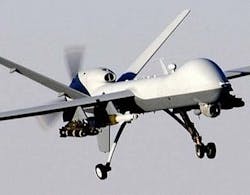MotionDSP to apply GPU-accelerated imagery enhancement to UAV-based persistent-surveillance sensors
WRIGHT-PATTERSON AFB, Ohio, 31 Aug. 2012. U.S. Air Force researchers are looking to image-processing expert MotionDSP Inc. in Burlingame, Calif., to use graphics processing unit (GPU) technology to enhance persistent-surveillance imagery gathered from sensors aboard unmanned aerial vehicles (UAVs).
Officials of the Air Force Research Laboratory at Wright-Patterson Air Force Base, Ohio, awarded a $3 million contract to MotionDSP this month to apply GPU technology for processing imagery from the Wide Area Airborne Sensor (WAAS) system.
The contract is part of the GPU-Accelerated Image Processing and Change and Ground Motion Detection for WAAS project, which seeks to improve surveillance imagery during bad weather, as well as to improve the WAAS system's ability to detect motion and changing conditions in persistent-surveillance imagery.
WAAS is a spherical array of cameras in a pod attached to UAVs such as the General Atomics MQ-9 Reaper. The system is designed to watch wide swaths of areas below to search for enemy activity, the planting of roadside bombs, and other suspicious activity. WAAS can capture motion imagery of an entire city for analysis.
MotionDSP provides GPU-accelerated image processing software to improve the quality of video captured from sources ranging from surveillance cameras to UAVs for military, law-enforcement, and commercial-security applications.
Among the investors of MotionDSP is NVIDIA Corp. in Santa Clara, Calif., which is among the most respected providers of off-the-shelf GPU technology in the world.
NVIDIA GPU chips have been designed-in to high-end computer gaming for graphics processing, as well as into advanced digital signal processing (DSP) systems for military applications like image processing, electronic warfare, and signals intelligence.
Military DSP experts have found the NVIDIA GPU chips provide efficient, fast parallel processing capabilities for complex DSP applications.
For more information contact MotionDSP online at www.motiondsp.com, NVIDIA at www.nvidia.com, or the Air Force Research Lab at www.wpafb.af.mil/AFRL.
Follow Military & Aerospace Electronics and Avionics Intelligence news updates on Twitter

